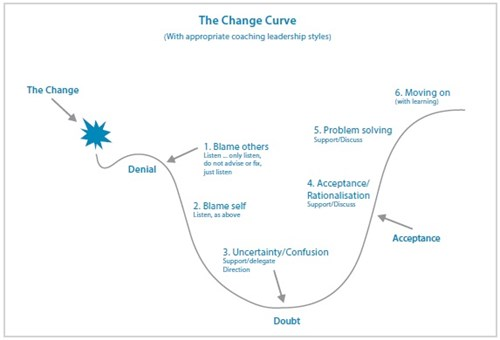It’s human nature to seek out comfort. Nobody wants to crawl out of a warm bed to get up for the day — especially if it’s cold outside of the cozy covers. Change is hard! That’s why it’s also human nature to resist it.

However, change is happening all the time — from technology, to regulations, to the internal processes that define how an organization operates. The need for change can seem obvious and sometimes even appealing, but that doesn’t make it easy.
The frequency of change is only going to increase as the technology and business landscapes evolve. That’s why it’s common and advisable for organizations to implement some kind of change management process.
Change management is the process of preparing for and executing a smooth transition or transformation at the organizational level.
When teams or businesses implement sweeping changes to processes, strategies, tooling, etc., they use a change management process to ensure adoption and measure the effects of those changes across the organization.
Given that change is so important, you might be surprised to learn that most change initiatives don’t work. According to Gartner, approximately 50 percent of change processes are unsuccessful.
Harvard Business Review published a great breakdown of five critical steps to execute a successful change management process. I encourage you to read it in full, but I’ll summarize the main points below:
To prepare for change, you need to look at both cultural and logistical elements. Remember, organizations are people at their core; making people aware of the need for change and gaining that initial buy-in is critical.
You know where you are today; this stage is about how you get to where you want to be.
Setting out a vision helps people see what the future may look like. The plan should include:
This involves following the plan and taking the steps that will take you from where you are now to where you want to be.
Sounds easy, but no plan ever accounts for everything. You will need to adapt as you learn along the way.
Remember, communication is crucial to keep people aware of how the change is progressing. Also, as much as possible, empower your people to take charge of the change they are responsible for.
Again, HBS advocates for a holistic approach. Think about the behaviors that make up cultures as well as processes and policies.
It is during this transitional stage a lot of hard work can be undone if people slip back to what is comfortable for them.
Change is rarely ever undertaken just to make a change. A goal is set out to be achieved and agreed upon as part of the project planning.
Once the plan is complete, review whether the goal was achieved and any lessons learned through the process.
Change management professionals use the ADKAR model to understand the components necessary to make changes successful.
Jeff Hiatt developed the ADKAR model after studying the change patterns of more than 700 organizations. ADKAR is an acronym that stands for awareness, desire, knowledge, ability, and reinforcement:
If you neglect even just one of the components described above, the change will not stick. For example, without reinforcement from leaders, people will inevitably regress back to what was comfortable before the change went into effect.
So, how can you use the ADKAR model as part of a change management process? For one, you can link it to the activities in your plan. Have you included training for the team? Do you need to budget for new equipment? Does your communication plan include senior leaders? If so, what do you expect of them?
You can also use this model as a self-assessment tool. I have found it particularly useful for gathering the team’s perspective on the change. After one such session, we realized our training plan was nowhere near good enough. So, we threw it out and worked with the team to design a new change management that helped them get comfortable with the system.
Organizations are collections of people and, at the end of the day, it’s people who will experience any change you implement. Your ability to support them is one of the most critical success factors when managing an organizational change.
The Change Curve is based on a model originally developed by Elisabeth Kübler-Ross in the 1960s to explain the grieving process. Today, it is widely used by change management practitioners to explain the process people go through when a change happens.
When used for change management purposes, the Change Curve features recommended steps and approaches for leaders to take at each stage. There are lots of different versions of the Change Curve, but here’s a typical example of how the model applies in practice:

As we go through the Change Curve, the type of support required evolves.
Getting through to the acceptance stage is critical for successful change. If people are not supported, they’re liable to get stuck at a certain stage and never advance.
Consider a change that has happened in your organization recently. Where did your people fall on this Change Curve?
Change is hard. As humans, comfort is not just the default, but a position we actively seek.
Cold? Put a jumper on. Hungry? Eat some food.
However, change is constant and required to stay competitive and compliant.
When making a change in your organization, make sure you have a plan, ensure you have all the ingredients that make up successful change (e.g., as per the ADKAR model), and do everything in your power to support your people.
Featured image source: IconScout

LogRocket identifies friction points in the user experience so you can make informed decisions about product and design changes that must happen to hit your goals.
With LogRocket, you can understand the scope of the issues affecting your product and prioritize the changes that need to be made. LogRocket simplifies workflows by allowing Engineering, Product, UX, and Design teams to work from the same data as you, eliminating any confusion about what needs to be done.
Get your teams on the same page — try LogRocket today.

Most teams fail at autonomy. Learn how clear rules help product teams move faster without micromanagement.

A practical framework for PMs to use AI in ideation without sacrificing judgment, strategy, or decision quality.

A practical five minute revenue estimation method to help product managers compare ideas, drop low impact features, and prioritize smarter.

A practical guide for PMs who want to stop being bottlenecks, delegate smarter, and lead teams effectively with a clear ownership framework.
3 Replies to "What is change management? 5-step process and guide"
I like how this post emphasizes the importance of embracing change, especially in today’s fast-evolving business environment. Change management is crucial for organizations to navigate these shifts effectively and stay ahead in the ever-changing landscape.
Change management is the structured approach to transition an organization or team from the current state to a desired future state.Nice knowledge-gaining blog. This post is the best on this valuable topic.
The content of your blog is excellent, and you cover each topic comprehensively, but I have a question about how small businesses can adapt to these changes and whether it will be beneficial to them. If you could reply, I would greatly appreciate it.